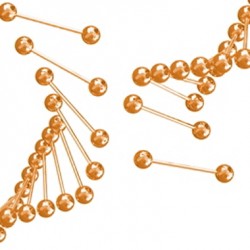By Helen Figueira
August 29, 2011
Time to read: 4 minutes
 CSC Meiosis: Sex cell DNA damage response
CSC Meiosis: Sex cell DNA damage response
Biological cells are often compared to factories, with ‘molecular machines’ that work in harmony to maintain metabolism and propagate genes. But as factories they are immensely complex: understanding individual components and the role they play helps scientists to build a picture of the processes of life.
The cohesin protein complex is one type of component in the cell factory, holding copied chromosomes or sister chromatids together until a cell divides, much like chromosome glue. It also helps to repair gaps in DNA called double strand breaks (DSBs) that can form during DNA replication or when a cell is damaged. In most cells of the body cohesin also helps to detect DSBs via damage checkpoints, cellular mechanisms based on chemical signalling. It loads onto DSBs, marking them for repair and helping to trigger a signal that halts cell division if breaks are not repaired in a timely fashion. Like a factory’s quality control officer, checkpoints cast aside imperfection – singling out those cells that haven’t been repaired for cell death or apoptosis.
Cohesin is also required for chromosome segregation and DSB repair during meiosis, the special cell division that forms sex cells – sperm and eggs – although there are some differences in the way meiotic DSBs are formed and repaired (see box below). “The interplay between DSB repair and sister chromatid cohesion may be different in meiosis,” explains CSC Meiosis Group Head Enrique ‘Fadri’ Martinez-Perez, “and actually how cohesin affects the repair of meiotic DSBs has not been well understood.” What hasn’t been clear before is if cohesin has any role in the operation of the DNA damage checkpoint during meiosis.
“You can’t make an egg without breaking some DNA”
DSBs are actually necessary in sex cells to allow meiotic recombination, the gene shuffling that makes everyone – apart from twins – genetically unique. The actual mechanism of repair is also different: In mitotic cells sister chromatids resulting from DNA replication are held together and the intact copy is used as a template to repair breaks, but in sex cells the homologous chromosome copy is used instead.
Fadri and his team study mechanisms of meiosis in a nematode worm called C. elegans. They genetically engineered the worm to be deficient in SCC-2, a protein that is required to load cohesin onto DNA. They found that DSBs necessary for meiotic combination were normally formed in mutants lacking SCC-2 during meiosis, but these breaks remained unrepaired, indicating an important role for cohesin in fixing meiotic DSBs. What’s more, these unrepaired DSBs didn’t induce an increase of cell death in worms lacking SCC-2, which suggested that cohesin may be important in the meiotic DNA damage checkpoint that kills off non-repaired cells.
In order to confirm the involvement of cohesin in the meiotic DNA damage checkpoint, they compared rates of cell death in meiotic cells from C. elegans that had been exposed to radiation. Normally radiation damage means many cells undergo apoptosis, but in the SCC-2 deficient worms, rates of apoptosis did not increase due to radiation damage. By tweaking cohesin levels they found there was a critical cohesin point below which the checkpoint failed to function. They also found that the lack of cohesin prevented the molecular ‘repair this‘ markers being attached to the break, in effect failing to alert the cell to the DSB to initiate repair. Furthermore, the recruitment of RAD-51, a protein critical for DNA repair, to DSBs induced by radiation was delayed by several minutes in worms lacking SCC-2. These observations show that cohesin is important in the earliest steps of the meiotic DNA damage response, something they didn’t expect.
“Our investigations have uncovered an unexpected role for meiotic cohesin in the early processing of DSBs and in the activation of the checkpoint,” confirms Fadri, “showing that cohesin is a key player in the early stages of the meiotic DNA damage response. “We’ve also shown that SCC-2 is required for cohesin loading during meiosis, thus demonstrating that the main mechanism of cohesin loading is conserved between the mitotic and the meiotic cell division programs.”
SJ
Reference
Lightfoot, J., Testori, S., Barroso, C., Martinez-Perez, E. (2011) Loading of meiotic cohesin by SCC-2 is required for early processing of DSBs and for the DNA damage checkpoint. Current Biology, in press. DOI 10.1016/j.cub.2011.07.007